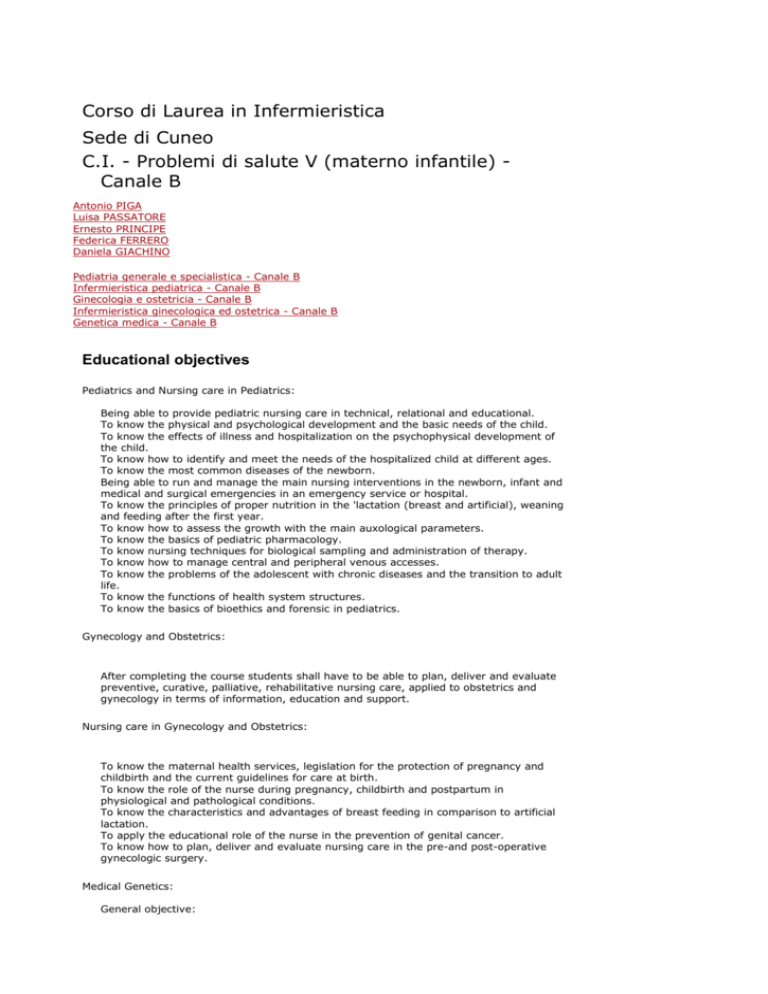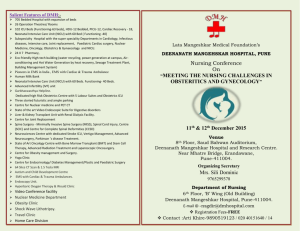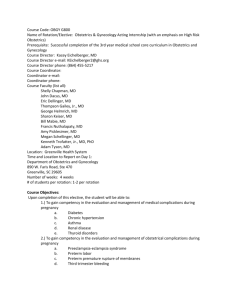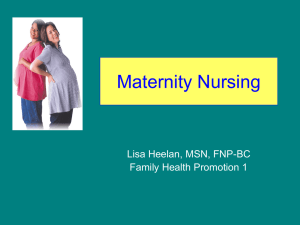Corso di Laurea in Infermieristica Sede di Cuneo C.I.
advertisement

Corso di Laurea in Infermieristica Sede di Cuneo C.I. - Problemi di salute V (materno infantile) Canale B Antonio PIGA Luisa PASSATORE Ernesto PRINCIPE Federica FERRERO Daniela GIACHINO Pediatria generale e specialistica - Canale B Infermieristica pediatrica - Canale B Ginecologia e ostetricia - Canale B Infermieristica ginecologica ed ostetrica - Canale B Genetica medica - Canale B Educational objectives Pediatrics and Nursing care in Pediatrics: Being able to provide pediatric nursing care in technical, relational and educational. To know the physical and psychological development and the basic needs of the child. To know the effects of illness and hospitalization on the psychophysical development of the child. To know how to identify and meet the needs of the hospitalized child at different ages. To know the most common diseases of the newborn. Being able to run and manage the main nursing interventions in the newborn, infant and medical and surgical emergencies in an emergency service or hospital. To know the principles of proper nutrition in the 'lactation (breast and artificial), weaning and feeding after the first year. To know how to assess the growth with the main auxological parameters. To know the basics of pediatric pharmacology. To know nursing techniques for biological sampling and administration of therapy. To know how to manage central and peripheral venous accesses. To know the problems of the adolescent with chronic diseases and the transition to adult life. To know the functions of health system structures. To know the basics of bioethics and forensic in pediatrics. Gynecology and Obstetrics: After completing the course students shall have to be able to plan, deliver and evaluate preventive, curative, palliative, rehabilitative nursing care, applied to obstetrics and gynecology in terms of information, education and support. Nursing care in Gynecology and Obstetrics: To know the maternal health services, legislation for the protection of pregnancy and childbirth and the current guidelines for care at birth. To know the role of the nurse during pregnancy, childbirth and postpartum in physiological and pathological conditions. To know the characteristics and advantages of breast feeding in comparison to artificial lactation. To apply the educational role of the nurse in the prevention of genital cancer. To know how to plan, deliver and evaluate nursing care in the pre-and post-operative gynecologic surgery. Medical Genetics: General objective: To know how to apply in professional practice the basic knowledge of human genetics acquired during previous courses, with focus on the common scenarios of maternalinfant care. Specific objectives: To know how to get family history and build family trees. To know how to manage and explain the transmission of ABO and Rhesus erythrocyte groups, monofactorial diseases, dominant and recessive, autosomal and X-linked, transmitted by maternal inheritance, multifactorial. To know how to manage the basic orientation in diagnosis and genetic counseling, particularly for: sickle cell anemia, cystic fibrosis, phenylketonuria, congenital deafness, congenital hip dysplasia, congenital malformations, mental retardation, adult neurodegenerative diseases, diabetes, cancer risk, genetically based adverse reactions to drugs. To know how to manage users of a family counseling center, with basic orientation on the principles, operating modes, potential and limitations of neonatal screening programs, and prenatal diagnosis of chromosomal aberrations and congenital malformations. Contents Pediatrics and Nursing care in Pediatrics: Neonatal childcare; adaptation of the newborn to extra-uterine life Clinical evaluation of the newborn at birth Normal and pathological newborn Pre-term and post-term newborn Breastfeeding and artificial lactation Weaning Feeding after the first year and in some pathological conditions Auxological parameters Exanthematic diseases Prophylaxis of infectious diseases Vaccines Psychophysical development and basic needs of the child Child and disease Normal and pathological puberty Outline of adolescentology Newborn and infant care: assessment by Apgar score, umbilical cord medication, infant hygiene Techniques for food administration , feeding tools sanitation Techniques for biological sampling and drug administration routes and modalities Monitoring of vital signs at various ages; posture and behavior observation. Main nursing interventions in medical and surgical emergencies in an emergency service or hospital Pediatric health services Existing legislation related to National and Regional Health Plan Outline of bioethics and pediatric pharmacology Gynecology and Obstetrics: Gynecological Endocrinology – Endometrial cycle Pelvic endometriosis Screening for breast cancer and uterine cervix cancer Climacteric and menopause Contraception Pregnancy health Main obstetric diseases Approach to the in-patient woman Breast cancer Nursing care in Gynecology and Obstetrics: - Outline of the history of childbirth healthcare, the Italian system, WHO recommendations, medicalization and demedicalization of birth, humanization of childbirth and protection of motherhood and fatherhood, health facilities and professionals of mother-child healthcare. - Role of the nurse in physiological pregnancy, in responsible procreation, prenatal diagnosis and voluntary interruption of pregnancy. Nursing care in pregnancy requiring hospitalization (threat of abortion, hyperemesis gravidarum, ectopic pregnancy, therapeutic termination of pregnancy, third trimester bleeding, hypertension in pregnancy, HELLP syndrome, threat of premature childbirth, gestosis, diabetes) - Obstetric care in normal and pathological childbirth and postpartum period. Breastfeeding guidelines. - Role of the nurse in obstetric emergencies: bleeding from abortion in progress, eclamptic crisis, premature detachment of normally inserted placenta, acute fetal distress, cord prolapse, bleeding from placenta previa. Nursing interventions in delivery in progress. - Prevention of female genital cancer. Nursing care in: breast surgery, vaginal and abdominal hysterectomy, ovarian surgery, diagnostic and therapeutic interventions in laparoscopy. Medical Genetics: The educational activity will be based on the presentation of the following exemplary scenarios: In a marriage guidance centre: first contact with users; In a prenatal diagnosis centre: telephone booking, reception, gathering basic data and medical history; In a consulting room of neurology, endocrinology, cardiology: telephone booking, reception, gathering basic data and medical history; In a center for rare diseases: booking the visit, reception, gathering basic data and medical history. Final exam Written test with multiple choice questions and / or open questions Texts The student can complete its preparation and deepen the topics on the following texts: Pediatrics: -Bona-Miniero, Pediatria Pratica, Ed. Min. Medica 2009 Gynecology and Obstetrics: - P.V. Grella; M. Mondino., S.Pecorelli, L.Zichella, Compendio di Ginecologia e Ostetricia, Monduzzi Editore. - G.Santoni, L.Sgariboldi, Ostetricia e Ginecologia, Ed. Sorbona Milano Nursing care in Gynecology and Obstetrics -Di Giacomo P., Rigon L.A., Assistenza infermieristica e ostetrica in area materno infantile, Casa Editrice Ambrosiana, Milano, 2002 -Linee guida nazionali”Assistenza alla gravidanza e al parto fisiologico”www.assr.it giugno 2004 -Wierdis T., Romanini C., Alba E., Arduini D., D’Addato F., Grio R., et al. Ginecologia e ostetricia (II edizione). Torino: edizioni Minerva medica, 2003 -OMS, Care in normal birth. A practical guide, 1996 http://whqlibdoc.who.int/hq/1996/WHO_FRH_MSM_96.24.pdf -Enkin M, Keirse MJNC, Neilson J et al. A Guide to Effective Care in Pregnancy and Childbirth, Oxford University Press, 2000 http://www.childbirthconnection.org/article.asp?ck=10218





